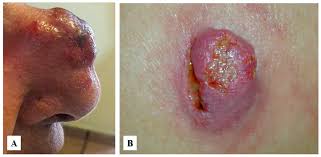Primary Cutaneous Anaplastic Large Cell Lymphoma (PC-ALCL) is a distinct subtype of CD30-positive T-cell lymphoproliferative disorders, predominantly manifesting in the skin without systemic involvement at the time of diagnosis. It is imperative to differentiate PC-ALCL from other forms of cutaneous or systemic lymphomas due to differences in clinical behavior, treatment, and prognosis.

Pathophysiology and Molecular Profile of PC-ALCL
PC-ALCL is characterized by the proliferation of large atypical lymphoid cells that strongly express the CD30 antigen. The neoplastic cells are typically anaplastic with pleomorphic nuclei, abundant cytoplasm, and prominent nucleoli. The tumor is often ALK-negative, distinguishing it from systemic ALK-positive ALCL.
Immunophenotype:
- CD30: Strongly positive in virtually all tumor cells
- ALK: Typically negative
- EMA: Frequently positive
- T-cell markers: Variable expression (CD2, CD3, CD4)
Genetic mutations associated with PC-ALCL include rearrangements in DUSP22 or TP63, with the former associated with a more favorable prognosis.
Clinical Presentation of Cutaneous ALCL
PC-ALCL typically presents as solitary or localized nodules, tumors, or plaques that may ulcerate. Lesions are usually located on the trunk or extremities. The disease predominantly affects middle-aged to older adults, with a slight male predominance.
Key Features:
- Solitary or grouped nodules/tumors
- Painless, reddish to violaceous appearance
- Possible ulceration
- Waxing and waning course in some cases
- Absence of systemic symptoms at diagnosis
Diagnostic Evaluation
Diagnosis requires a combination of clinical, histopathological, and immunohistochemical analysis.
Steps in Diagnosis:
- Skin Biopsy: Histopathology shows large, pleomorphic, CD30-positive lymphoid cells.
- Immunohistochemistry: Crucial to confirm CD30 expression and exclude ALK positivity.
- Imaging (PET/CT): To rule out systemic involvement.
- Bone Marrow Biopsy: Performed if systemic disease is suspected.
A multidisciplinary approach involving dermatologists, oncologists, and pathologists is essential for accurate diagnosis.
Differential Diagnosis
It is vital to differentiate PC-ALCL from other CD30-positive and CD30-negative lymphomas:
- Lymphomatoid papulosis (LyP): Often regresses spontaneously, but may coexist with PC-ALCL.
- Systemic ALCL: Usually ALK-positive and shows systemic spread.
- Mycosis fungoides (transformed): May present similarly in advanced stages.
Treatment Strategies for PC-ALCL
Therapeutic approaches depend on the extent of the disease (localized vs. multifocal) and patient-specific factors.
Localized Disease:
- Surgical excision
- Radiotherapy (30-45 Gy): Effective in solitary lesions
Multifocal or Recurrent Disease:
- Brentuximab vedotin (anti-CD30 antibody-drug conjugate): High response rates
- Low-dose methotrexate or bexarotene: In indolent/recurrent disease
- CHOP chemotherapy: Reserved for aggressive or refractory cases
Relapse occurs in approximately 40% of cases, but long-term prognosis remains favorable.
Prognosis and Survival Outcomes
PC-ALCL generally carries an excellent prognosis with a 5-year survival rate exceeding 90% in localized disease. Prognosis worsens in cases with extracutaneous dissemination, especially in the absence of DUSP22 rearrangement or presence of TP63 rearrangement.
| Prognostic Factor | Impact on Outcome |
|---|---|
| Localized vs. disseminated | Better outcomes in localized |
| DUSP22 rearrangement | Favorable prognosis |
| TP63 rearrangement | Poorer survival |
| ALK expression | Typically absent |
Follow-Up and Monitoring
Lifelong follow-up is advised due to the potential for recurrence and the risk of progression to systemic disease.
- Every 3–6 months: Clinical skin exam, imaging if symptoms suggest progression
- Patient education: Important for early identification of new or recurrent lesions
Primary Cutaneous Anaplastic Large Cell Lymphoma represents a unique and often indolent form of CD30-positive cutaneous T-cell lymphoma. Accurate diagnosis, differentiation from similar disorders, and tailored therapeutic strategies are essential for effective management and excellent long-term outcomes. As research progresses, molecular profiling will play an increasingly important role in prognostication and individualized therapy.